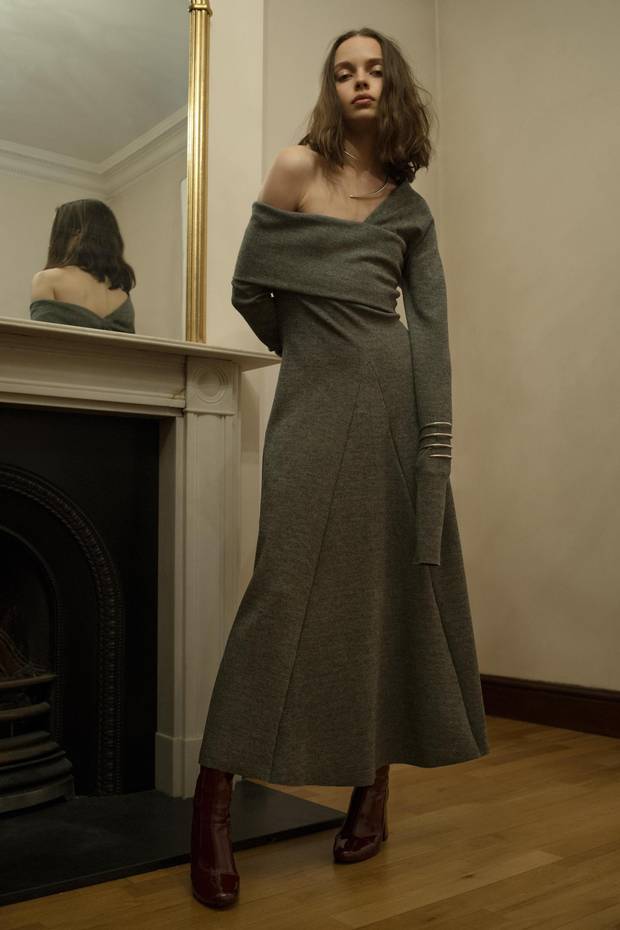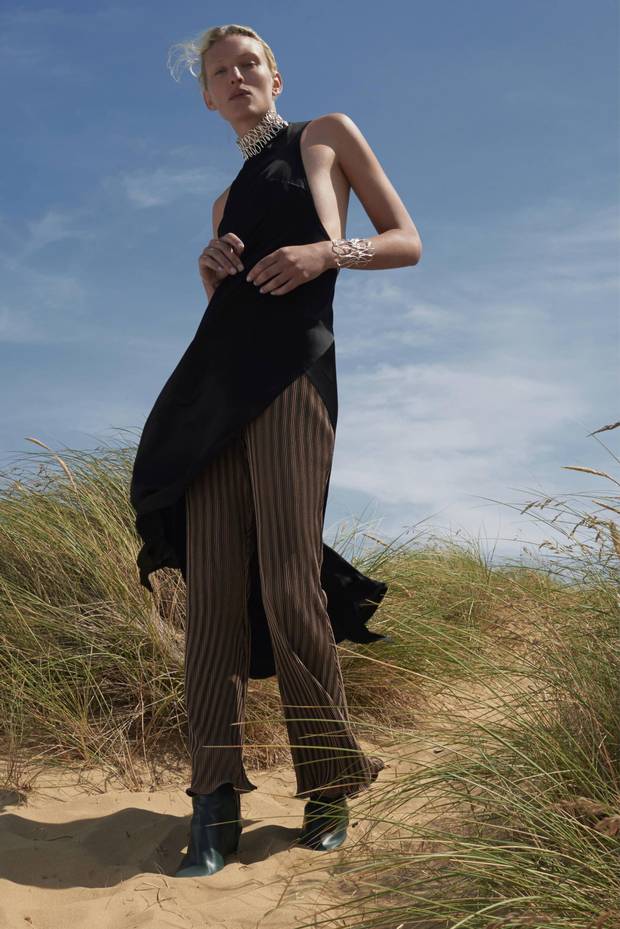Many sisters dream and scheme about creating their own fashion collection, but few have the wherewithal to bring their fantasies to reality. Toronto's Chloé and Parris Gordon, who presented their spring 2017 offering in New York in September to critical acclaim, must be pinching themselves daily. Not only has their Beaufille label started to get the right editorial tongues wagging and more influential buyers writing orders, but celebrity style icons like Lady Gaga and Selena Gomez are donning their wares.
Chloé, 29, and Parris, 26, studied their métier at the Nova Scotia College of Art and Design (NSCAD) before launching their first label, Chloé Comme Parris, in 2009. Four years and a few lessons later, the sisters successfully rebranded, changing their moniker to Beaufille. Regulars on the Toronto fashion circuit, the sisters jumped at the chance to make their Big Apple debut at New York Fashion week last February.
I dropped in on the Gordon sisters at their Toronto studio last month as they were preparing to show their new collection, and chatted with the duo about their Canadian-made designs, their tenacity and what first fuelled their fashion dreams.
Lady Gaga, in suede separates from Beaufille.
Broadimage/REX Shutterstock/Rex Feature Ltd.
As sisters growing up in the same household, what inspired you?
Chloé Gordon: Our mother is a fine artist and she sparked our imagination from a young age, because she would paint a different wall, ceiling or section of the floor each week. Over the years, there was always a new project on the go. I remember her rolling out long sheets of brown paper and giving us all these supplies and saying, "Go nuts!" Then she'd use it as Christmas wrapping paper. Also, she sewed a lot of her own clothes and her best friend was a seamstress. I learned how to sew from them. And she kept every issue of Vogue since she was 16!
Parris Gordon: So we just have this crazy archive. And then with our dad being a businessman and an entrepreneur, well, that's what made us be in the business of art, which is fashion.
When you told your parents that you wanted to start your own label, were they encouraging from the get-go?
C.G.: It came as a bit of a shock because I first went to Dalhousie not knowing what I wanted to do. Our parents always wanted us to go into the arts, so they were very supportive. Within the first few months at Dalhousie University, I knew I wanted to go to art school, so I enrolled at NSCAD. My parents said they knew that this was always brewing inside. Parris came to visit me and I showed her around the school. She was so inspired, she decided she wanted to do that too. We were really close growing up and always talked about being creative together but we didn't know in what way.
P.G.: Until we started making product. Our parents have been nothing but supportive. After finishing school, most artists have to work a part-time job. But when our collection got into two Toronto boutiques, our parents urged us to put all our focus into this and work from home if we needed to. They supported it fully and to this day, they're just as involved.
When did you realize just how seriously you had to take branding the business?
P.G.: In 2013, when we rebranded. We were putting out a lot of collections but not getting much traction. After five or six seasons of showing at Toronto Fashion Week and then starting Beaufille, it became apparent. You start realizing what the business of fashion is about and that you have to sell to stay afloat. That mentality came along with rebranding. We said, "No more prints, no more jewellery on clothing." We decided to go minimal, strip it all down and do what felt right in our gut. That was the first collection that started picking up really good international retailers and it went up on Vogue.com.
C.G.: We looked at our collection and asked, "What is the essence of what we're trying to say? Who is wearing this? Where are they going?" Just thinking about it in a more real-life setting rather than a fantasy setting was important.


Angles are at play in a dress from the label’s fall 2016 collection and pieces from the spring 2017 collection.
Photos courtesy of Beaufille/Sarah Blais
You have a lot of tenacity, but what about patience?
P.G.: One of the best parts of fashion is the cycle in the calendar that gives you deadlines. Patience is something that Chloé has had ingrained in her since day one. I'm learning and getting way better at it, but I wouldn't have made it this far without Chloé's patience.
C.G.: I've always understood where we could go. It was just about having the time and experience to know how to utilize all that information. Doing it ourselves, every mistake has felt real, whereas when you work for someone, maybe you don't feel the mistakes as much. We felt every failure, every bit of rejection, and it's empowered us to be stronger. When we first went to show in New York last season, there were naysayers, and we knew that this was the last bit of money we had to invest. We were going to take this risk and knew that if it didn't work out, we'd have to accept that. But it was a life-changing season. We got into 25 new retailers, including Net-a-Porter. And that's helped change our business completely.
So would you say it's imperative for young Canadian designers who want to get serious and have a substantial business to show in New York?
P.G.: I do, under the right umbrella. I think if we didn't show in New York we might have gotten a few more boutiques and that would have helped, but it would have been a Band-Aid solution. You need to create hype and that's what New York can do.
The whole notion of holding fashion weeks is being debated. Toronto Fashion Week has even been wiped out for this season. Do you think having a fashion week in Toronto is important?
P.G.: I do. Fashion month internationally seems crazy sometimes for editors, buyers and press who are going from city to city. The shows are a circus. But I think that's also what builds up hype around the industry and makes people who aren't in it, but love fashion, have more desire for it. Toronto has all the ingredients it needs. It just needs to rethink the strategy.
Quality is key for you with your fabrics. I know that NSCAD puts a lot of emphasis on textiles. All of eastern Canada really has appreciation for that kind of craftsmanship.
C.G.: When you're making something from scratch, you really understand how a piece is made. Our school was very good about that. Quality was a huge part of our grades so that's helped us. Even this past season, with the way we've been growing, we've been outsourcing our production to different places in Toronto, and we can hold a certain standard knowing that the samples we made in-house are perfect. We know exactly how we want things made and then we pass it off to the next person with that perfect sample in mind. There's so much industry here in Canada that needs to be revitalized. There are so many contractors, so many people waiting to make clothes.
You're designing for a sensibility and a certain kind of style that seems to have nothing to do with age. I'm sure your mother wears a lot of the stuff, too.
P.G.: Our 92-year-old grandmother wears it, too! She has that red outfit that Lady Gaga wore. Our grandma kills! People asked us who wore it better – and you can't say our grandmother didn't look very good in it.
This interview has been condensed and edited.